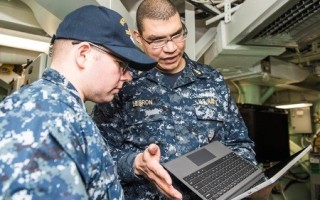U.S. Navy sonar tech improves anti-submarine warfare capabilities
OtherApril 08, 2016

Among the winners of the Secretary of the Navy (SECNAV) Innovations awards is Chief Sonar Technician (Surface) Benjamin Lebron, who improved the way Sonar Technicians in the fleet tracked and located submarines. Hooyah, Chief!
The SECNAV Innovations awards provide Department of the Navy (DON) military and civilian personnel and outlet to find novel solutions to issues around the fleet. I love this because while I was answering the call to cleaning stations – “sweepers, sweepers man your brooms,” – there are sailors out there actually making a difference.
Over 300 innovations were submitted and “the work of these individuals and teams represents a cultural change in the way we think through and solve challenges in our organization. Hopefully, this recognition inspires the next generation of innovators," says Scott Hargate, the awards coordinator in a Navy.mil article.
Mass Communication Specialist 3rd Class (MC3) Patrick Dionne, Navy Public Affairs Support Element Japan describes Chief Lebron’s program, called the Single Leg Bearing Range (SLBR), as a passive target-motion analysis system that aids in making decisions in seconds, and it can be used on any computer.
SLBR can be modified and adapted as it evolves with use by Sonar Technicians throughout the fleet, continues MC3 Dionne. The program was adopted by Chief Lebron's Arliegh-Burke ship, the USS Fitzgerald (DD-62), and it went into use during Talisman Sabre 15 and on multiple patrols in the South China Sea.
“When dealing with SONAR, in addition to looking at all the acoustics, you also have to deal with all the bearing information. SLBR allows Sailors to input all the information and it draws out the lines of sound geometries and presents the information for you,” says Lebron. “So instead of being 10 or 15 minutes behind the problem, the program can solve it seconds after you take the measurements.”
The program allows for innovation in the fleet. I don’t remember a moment when innovation was part of my daily activities, but I was also busy trying to avoid unwanted electricity to pass through my body during my own stint in the Navy.
Chief Lebron won under the category Enlisted Innovator of the Year. The rest of the winners are as follows and a thank you to the U.S. Navy for providing a list of innovators that do more than just clean!
- Data Analytics Category: Philip W. Gillett and Christian M. Sarofeen from Naval Surface Warfare Center, Carderock Division
- Additive Manufacturing Category: Denise Orthner, Kamal Bhakta, Nicholas Cavaliere, Ian Gallagher, Steven Orciuolo Sensor from Naval Air Systems Command
- Innovation Leadership Category: Cmdr. Jeffrey L. Heames, commanding officer, USS Preble (DDG 88)
- Innovation Scholar (PME) Category: Lt. Brendan Geoghegan from the Naval Postgraduate School
- Innovation Scholar (Midshipmen) Category: Midshipman Annie McDonald from Navy ROTC Unit, The George Washington University
- Innovation Catalyst Category: Keith Archbold, Allan Weidenheimer, Jeremy Hyland, Robert Alvey, David Reed, Mitch McCrory Department of Energy (DOE), Alex Roesler DOE, John Mulder DOE, Phil Turner DOE, Lon Dawson DOE from Naval Undersea Warfare Center Division, Keyport; Naval Surface Warfare Center Philadelphia Division; and Department of Energy partners at Sandia National Laboratories
- Outside the Box Category: Daniel M. Robinson from the Naval Research Laboratory





